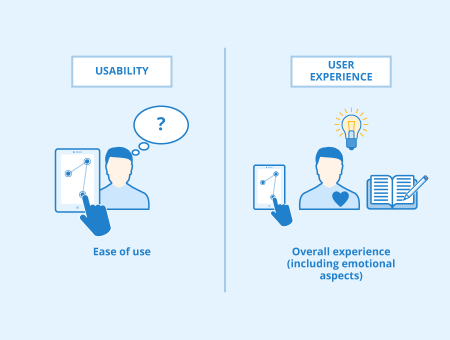Usability
Contents
Definition
The term usability describes how easy it is to use a website in practice. Criteria such as clarity of design, user-friendliness, and accessibility play an important role for this. Basically, it is about how easy it is for users to get to the desired content. The homepage design is of crucial importance here because it provides the first impression of what you have to offer and is also the table of content for your entire website.
Difference between usability and user experience

The terms “usability” and “user experience” are often used interchangeably, but strictly speaking, this is not correct. While the two concepts have large crossovers, they do not describe the same issue. Whereas usability refers only to the ease of use of a website, user experience is more about the overall visitor experience, which also includes emotional aspects.
Metaphorically speaking, usability is supposed to address a user's head with convincing technology, while user experience is also about emotional aspects and the right gut feeling when using a website. A website should therefore not only be as user-friendly as possible but also offer a positive user experience. Both aspects have to be taken into account appropriately and complement each other, because then users are rationally convinced and emotionally picked up, which increases the likelihood of frequent visits to your site.
Both areas have their own standards as subcategories of ISO 9241, which deals with the interaction between humans and computers. Usability falls under No. 11, while processes for designing serviceable interactive systems are covered under No. 210.
Criteria for good usability
An important aspect that can contribute greatly to good usability is a website's design. You should make sure that individual pages are as clearly arranged as possible. It is also important to consider certain user habits in the design, for example regarding the layout of a page. The navigation bar should be placed in a way that quickly catches users’ eyes. Furthermore, good legibility of your content is crucial. In addition to sufficiently large letters, you should select a font that is easy to read on each platform and device. Simply designed letters are more suitable for this purpose.
In addition to a website's design, usability is also about its content, for example when it comes to intuitive navigation. Besides the design and placement of the menu bar, the description of individual menu items is also highly relevant. When assigning keywords to individual sections, you should use common terms, so that visitors can easily find what they are looking for.
Another significant point is the optimization of page load times. An extensively crafted design may look great, but it can quickly lead to loading problems with slow internet connections or mobile use. Long load times can result in high bounce rates and short dwell times. To prevent this, you should avoid videos that are played automatically, for example. Even if users find the content useful, automatic playback requires a lot of bandwidth. It is therefore important in terms of usability to keep pages’ design appealing and useful, but also economical in terms of data volume.
Benefits of good usability
Usability is relevant to the success of your websites in various respects. For one thing, websites with great usability are visited much more regularly. In addition, good usability usually also increases the dwell time during individual visits. Furthermore, a company's website is often the first touchpoint for customers, partners, and potential new employees. A user-friendly website is therefore important for your company's first impression on such visitors. Last but not least, good usability combined with good user experience leads to overall user satisfaction.
Importance for SEO
In addition to increasing the value your website provides to visitors, usability is also highly relevant for your search engine rankings. Well-designed and user-friendly websites usually have a lower bounce rate, which is a quality signal for Google. Increasing the interaction and dwell time of users can also have a positive impact on your rankings. Furthermore, easy-to-use websites that provide value to users are often shared with friends and other contacts.
Usability, therefore, has a significant indirect influence on the search engine optimization (SEO) of a website.
Related links
- https://medium.com/@NoriCode/10-usability-rules-for-user-interface-design-ux-55bde4a1967f
- https://www.interaction-design.org/literature/article/an-introduction-to-usability
Similar articles
| About the author |
 |